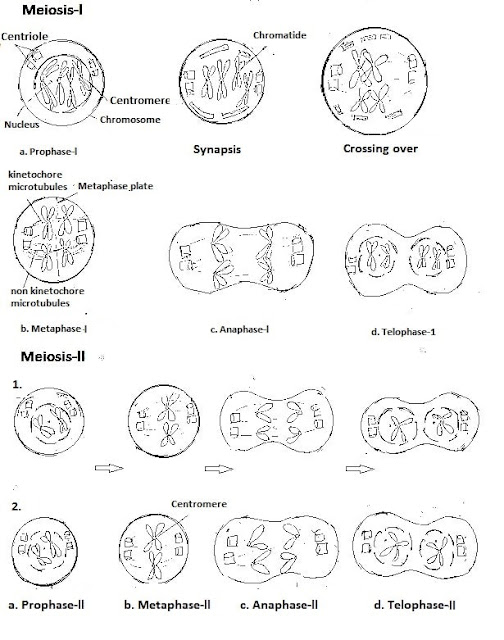What is Meiosis?
Meiosis is the process of cell division that occurs in the
formation of reproductive cells (gamete or sex cell - ova or spermatozoa
or sperm).
Meiosis is a type of cell division that reduces the
number of chromosomes in the parent cell by half and produces four gamete
cells. Meiosis produces four haploids (n)
gametes cells that are genetically unique or different from each other and the
original parent (germ) cell.
Get details on the cell cycle
and types of cell division. What are the phases involved in the cell cycle and cell division process?
Gametes are referred to as organisms' reproductive cells or sex
cells. The female gametes are known as ova or egg cells and the male
gametes are called sperm. Gametes are haploid cells (contain 23
chromosomes), and each cell carries only one copy of each chromosome.
Check out here what the differences
between mitosis and meiosis are?
Reproduction Cell Division
Stages of
reproduction cell division involve-
1. Meiosis
a. Meiosis-l (Reductional division)
b. Meiosis-ll (Equatorial division)
2. Cytokinesis

Phases of Meiosis
Undergoing meiosis, the cell goes through the interphase phase, in which the cell grows in size, chromosomes replicate,
Chromosomes of diploid ell
doubled, centriole replicates, and check all system to ensure that
it is ready to divide.

A. Meiosis – l
Meiosis-I is called the reduction division
because it results in the reduction of the chromosome number from diploid (46
chromosomes; cell has two copies of each chromosome, one maternal and one
paternal chromosome) to haploid (23 chromosomes; cell has only one copy of each
chromosome, either maternally derived or paternally derived chromosome).
Stages of Meiosis-I
Meiosis-I stages are;
a. Prophase- l
b. Metaphase –l
c. Anaphase –l
d. Telophase -l and cytokinesis
a. Prophase- l
1. Nuclear envelope breaks down and nucleoli disappear.
2. Chromosomes get shortened and thicken.
3. Mitotic spindle fibre appears.
4. Centrioles start to move toward opposite poles.
5. Chromosomes become arranged in homologous pairs,
chromosomes ends are attached to the nuclear envelope.
Crossing over
Crossing over is a process of the exchange of genetic material between non-sister chromatids of homologous chromosomes during meiosis. It takes place during the formation of gametes.
A portion of one chromatid may be exchanged with the portion of
another chromatid, which results in “Genetic recombination”. This results formation
of new combinations (allelic combinations) of genes in the daughter cell.
2. Metaphase-l
Chromosomes start
to move toward the equator of the cell. The homologous pair of chromosomes align
on either side of the metaphase plate of the cell.
3. Anaphase- l
The homologous pair is pulled to move opposite poles of the
cell by microtubules attached to the centromere.
The sister chromatids of each chromosome remain attached to
one another and centromeres don’t separate and paired chromatids held by
centromere remain together.
4. Telophase- l and Cytokinesis
In this phase when the chromosomes have finished moving to the opposite poles of the cell then it is followed by cytokinesis, which results to produce two daughter cells.
After cytokinesis, two haploid daughter cells are genetically
different chromosomes produced after meiosis I.
Interkinesis
Interkinesis is the time between the formation of daughter
cells, meiosis-l, and meiosis-ll.
B. Meiosis-ll
Meiosis II is the second part of the meiotic process which divides each haploid meiotic cell into two different daughter cells.
During meiosis II, the sister chromatids within the two
daughter cells get separated to form four new haploid gametes.
Stages of Meiosis ll
Meiosis- ll stage involves;
a. Prophase –ll
b. Metaphase-ll
c. Anaphase-ll
d. Telophase-ll and Cytokinesis
a. Prophase –ll
Prophase II stage that follows after meiosis
I. The nuclear envelope and the nucleolus break down during prophase II.
The spindle fiber are formed, centrosomes
move toward the opposite poles and the spindle microtubules begin to capture
chromosomes.
b. Metaphase-ll
Chromosomes align at the metaphase plate through the facilitation of the spindle fibers.
c. Anaphase-ll
The centromere split and the attached sister chromatids
separate and move toward opposite poles of the cell.
d. Telophase-ll
Nuclear membrane forms around the four haploid nuclei.
Telophase ll is followed by cytokinesis, resulting in a produce four haploid
cells that are genetically dissimilar.
Cytokinesis
Cytokinesis produces four haploid cells that are genetically
different haploid cells (n).
Meiosis l begins with a diploid starting cell and
ends with two haploid numbers of chromosomes, where each chromosome is made up
of two connected sister chromatids.
During meiosis-ll, each of two haploid cells formed
during meiosis- l divide,
and sister chromatids
are separated. This result produces four haploid (n) gametes that are genetically
different from the original diploid (2n) starting cell.
Know here what phases of mitosis are.







0 Comments